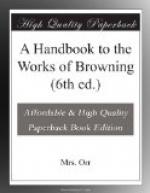[Footnote 57: The Cardinal himself reviewed this poem, not disapprovingly, in a catholic publication of the time]
[Footnote 58: This refers to the popular Neapolitan belief that a crystallized drop of the blood of the patron saint, Januarius, is miraculously liquefied on given occasions.]
[Footnote 59: The “Iketides” (Suppliants), mentioned in Section XVIII., is a Tragedy by AEschylus, the earliest extant: and of which the text is especially incomplete: hence, halting, and “maimed.”]
[Footnote 60: This poem, like “Aristophanes’ Apology,” belongs in spirit more than in form to its particular group. Each contains a dialogue, and in the present case we have a defence, though not a specious one of the judgment attained]
[Footnote 61: We recognize the cogito ergo sum of Descartes.]
[Footnote 62: The narrator, in a parenthetic statement, imputes a doctrine to St. John, which is an unconscious approach on Mr. Browning’s part to the “animism” of some ancient and mediaeval philosophies. It carries the idea of the Trinity into the individual life, by subjecting this to three souls, the lowest of which reigns over the body, and is that which “Does:” the second and third being respectively that which “Knows” and “Is.” The reference to the “glossa of Theotypas” is part of the fiction.]
[Footnote 63: The present Riccardi palace in the Via Larga was built by Cosmo dei Medici in 1430; and remained in the possession of the Medici till 1659, when it was sold to Marchese Riccardi. The original Riccardi palace in the Piazza S. S. Annunziata is now (since 1870) Palazzo Antinori.
In my first edition, the “crime” is wrongly interpreted as the murder of Alexander, Duke of Florence, in 1536; and the confusion, I regret to find, increased by a wrong figure (8 for 5), which has slipped into the date.]
[Footnote 64: Mr. Browning possesses or possessed pictures by all the artists mentioned in this connection.]
[Footnote 65: (Verses 26, 27, 28.) “Bigordi” is the family name of Domenico called “Ghirlandajo,” from the family trade of wreath-making. “Sandro” stands for Alessandro Botticelli. “Lippino” was son of Fra Lippo Lippi. Mr. Browning alludes to him as “wronged,” because others were credited with some of his best work. “Lorenzo Monaco” (the monk) was a contemporary, or nearly so, of Fra Angelico, but more severe in manner. “Pollajolo” was both painter and sculptor. “Margheritone of Arezzo” was one of the earlier Old Masters, and died, as Vasari states, “infastidito” (deeply annoyed), by the success of Giotto and the “new school.” Hence the funeral garb in which Mr. Browning depicts him.]
[Footnote 66: The “magic” symbolized is that of genuine poetry; but the magician, or “mage,” is an historical person; and the special feat imputed to him was recorded of other magicians in the Middle Ages, if not of himself.
“Johannes Teutonicus, a canon of Halberstadt in Germany, after he had performed a number of prestigious feats almost incredible, was transported by the Devil in the likeness of a black horse, and was both seen and heard upon one and the same Christmas day to say Mass in Halberstadt, in Mayntz, and in Cologne” ("Heywood’s Hierarchy,” bk. iv., p. 253).




